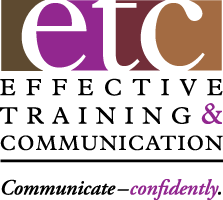Last month’s feature on ‘Message in the Middle’ was a real hit, based on reader comments and questions. As promised, here are some message-related Best Practices to help you accomplish your presentation outcomes.
- Presentations fall into three broad categories: informational or ‘Tell’ messages, persuasive or ‘Sell’ messages and Motivational or ‘Yell’ messages. Since the outcome will be different, even if the audience is the same, plan your ‘Message in the Middle’ accordingly.
- Even with a purely informational presentation, there’s usually a small ‘Sell’ message connected with it. If you’re telling an employee group about the heightened workplace security measures and the new procedure to follow, it usually helps to remind them why it’s important and what’s in it for them with a brief ‘Sell’ message.
- Each Sub-Point is a mini-presentation unto itself. Each has a brief introduction that overviews the purpose and content to follow and a brief summary, potentially reconnecting with the Main Point before moving on to the next Sub Point.
- Simple transitional phrases or ‘guide posts’ should help the audience move from one content point to the next, such as ‘Our next example …’, ‘The third potential cause of the problem is …’ or ‘Now, let’s look at the impact of … ‘An essential audience-centric technique, these transitions make it easy for the audience to stay on track with your message. They’ll appreciate your courtesy.
- The sequence of Sub Points depends on your outcome and audience needs. With a persuasive proposal, it’s typically ‘Problem – Causes – Solutions – Recommendation – Implementation.’ Some messages fare better with a ‘Yesterday – Today – Tomorrow’ approach. Informational messages often take the journalism focus of ‘Who – What – Where – When – Why’.
- If there’s no obvious logical sequence that makes sense, consider leading with your strongest Sub-Point, the one you’d use if you only could have one. End with your second strongest and put the weakest in the middle.
- When you plan your content points for each Sub-Point, list every one you could mention. Force-rank them first to last based on audience needs and impact. Then, cut from the bottom up to fit your time limit. Better to have only two or three strong ones than so many that they lose impact.
- In a written proposal, you might have some references listed at the end with appropriate in-text citations or footnotes. With an oral proposal, the audience needs to directly connect the source with the fact, comment or statistic. Don’t just rely on the small print footnote on your slide – verbalize it.
- For example, say something like ‘The 2017 NLRB Trends Study indicates … ‘, ‘According to management expert and author Tom Peters … ‘or ‘When XYZ Inc. tried this program, CFO Diane Wilson offered these observations … ‘. Bottom line, never let the audience ask themselves ‘Says who?’ or ‘Who’s that?’ That self-talk distracts them from listening and might erode the credibility of your message.
Add these Best Practices to your Presenter’s Tool Kit to make sure your Message in the Middle is Effective, Efficient and Engaging and accomplishes your presentation outcomes with your target audience. It’s what they need and want to hear to understand and accept your Main Point.
If it sounds like a lot of work, you’re right. But that’s what it takes to make the Varsity Presenter Team. Better get busy – tryouts are coming up soon.
